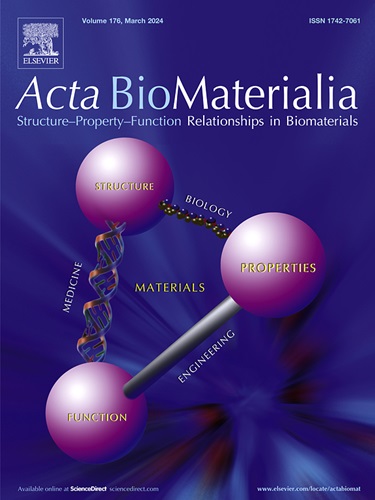氨基酸支链自由基树状大分子作为脑肿瘤MRI造影剂的合成及弛豫性研究。
IF 9.4
1区 医学
Q1 ENGINEERING, BIOMEDICAL
引用次数: 0
摘要
本研究介绍了一系列水溶性自由基树状大分子(G0至G5)作为有前途的磁共振成像(MRI)造影剂,可能潜在地解决与当前钆基造影剂相关的临床安全性问题。通过基于环三磷腈核心和赖氨酸衍生分支单元的简化合成方法,我们成功地开发了含有多达192个2,2,6,6-四甲基胡椒酰氧基(TEMPO)自由基的G5树状大分子。这种合成方法的优点包括易于制备、纯化和通过谷氨酸阴离子残基的掺入可调节水溶性。采用1H-NMR、FT-IR、SEC-HPLC等手段对其结构和纯度进行了综合表征。电子顺磁共振(EPR)谱分析表明,高代树状大分子中的TEMPO基团在局部环境中表现出较低的迁移率和较强的自旋交换。体外MRI显示,随着树突状分子代数的增加,松驰度(r1)增加,其中G5表现出异常高的r1,超过24 mM-1s-1。分子动力学模拟提供了对结构-性质关系的重要见解,揭示了水可及性对TEMPO基团增强弛豫性的重要性。Vero细胞活力试验表明G3和G3.5具有良好的生物相容性。小鼠体内MRI实验表明,G3.5通过肾脏排泄,并选择性地积聚在胶质母细胞瘤肿瘤中。意义声明:本研究探索了一类基于有机自由基树状大分子的MRI造影剂,作为钆基造影剂的潜在替代品。我们提出了一种简化的水溶性树状大分子的合成方法,其中含有多达192个TEMPO自由基单元,这是迄今为止该类化合物中获得的最高数量,从而产生了创纪录的高弛度值。我们的方法提供了更容易的制备,纯化和可调的水溶性,代表了现有方法的改进。通过结合实验和计算研究,我们提供了对控制弛豫的结构-性质关系的见解。体内实验证明树突状分子具有胶质母细胞瘤成像的潜力,主要是肾脏排泄。这项工作代表了开发无金属MRI造影剂的一步,具有良好的弛豫性和生物相容性,可能为诊断成像研究开辟新的途径。本文章由计算机程序翻译,如有差异,请以英文原文为准。

Synthesis and Relaxivity study of amino acid-branched radical dendrimers as MRI contrast agents for potential brain tumor imaging
This study introduces a series of water-soluble radical dendrimers (G0 to G5) as promising magnetic resonance imaging (MRI) contrast agents that could potentially address clinical safety concerns associated with current gadolinium-based contrast agents. By using a simplified synthetic approach based on a cyclotriphosphazene core and lysine-derived branching units, we successfully developed a G5 dendrimer containing up to 192 units of 2,2,6,6-Tetramethylpiperidinyloxy (TEMPO) radical. This synthesis offers advantages including ease of preparation, purification, and tunable water solubility through the incorporation of glutamic acid anion residues. Comprehensive characterization using 1H NMR, FT-IR, and SEC-HPLC confirmed the dendrimers' structures and purity. Electron paramagnetic resonance (EPR) spectroscopy revealed that TEMPO groups in higher generation dendrimers exhibited decreased mobility and stronger spin exchange in their local environments. In vitro MRI showed that relaxivity (r1) increased with higher dendrimer generations, with G5 exhibiting an exceptionally high r1 of over 24 mM-1s-1. Molecular dynamics simulations provided crucial insights into structure-property relationships, revealing the importance of water accessibility to TEMPO groups for enhancing relaxivity. Vero cell viability assay demonstrated G3 and G3.5 have good biocompatibility. In vivo MRI experiments in mice demonstrated that G3.5 was excreted through the kidneys and selectively accumulated in glioblastoma tumors.
Statement of significance
This study explores a class of MRI contrast agents based on organic radical dendrimers as a potential alternative to gadolinium-based agents. We present a simplified synthesis method for water-soluble dendrimers containing up to 192 TEMPO radical units—the highest number achieved to date for this class of compounds—resulting in record-high relaxivity values. Our approach offers easier preparation, purification, and tunable water solubility, representing an improvement over existing methods. Through combined experimental and computational studies, we provide insights into the structure-property relationships governing relaxivity. In vivo experiments demonstrate the dendrimers' potential for glioblastoma imaging, with predominantly renal excretion. This work represents a step towards developing metal-free MRI contrast agents with promising relaxivity and biocompatibility, potentially opening new avenues for diagnostic imaging research.
求助全文
通过发布文献求助,成功后即可免费获取论文全文。
去求助
来源期刊

Acta Biomaterialia
工程技术-材料科学:生物材料
CiteScore
16.80
自引率
3.10%
发文量
776
审稿时长
30 days
期刊介绍:
Acta Biomaterialia is a monthly peer-reviewed scientific journal published by Elsevier. The journal was established in January 2005. The editor-in-chief is W.R. Wagner (University of Pittsburgh). The journal covers research in biomaterials science, including the interrelationship of biomaterial structure and function from macroscale to nanoscale. Topical coverage includes biomedical and biocompatible materials.
 求助内容:
求助内容: 应助结果提醒方式:
应助结果提醒方式:


